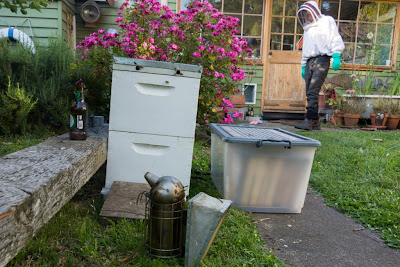I got onto this item a bit late. About a month ago, varroa mites were detected and destroyed in Sydney. Their progress is inevitable, and scary, for many reasons....
This article lifted from the ABC website:
http://www.abc.net.au/rural/news/content/201211/s3639408.htm
Asian honeybees and Varroa mites detected and destroyed in Sydney
By Kim Honan and Robin McConchie
Friday, 23/11/2012
Thousands of Asian honey bees have been detected and destroyed on a ship at Kurnell in southern Sydney.
The swarm of 2000 bees was also carrying more than 150 Varroa mites, a pest that has decimated bee populations across the world.
The Department of Agriculture, Fisheries and Forestry had targetted the bulk fuel carrier for inspection because of previous ports it had visited.
Tim Chapman, the Border Compliance Division's first assistant secretary, says it came from Singapore but before that it had been to ports in the Far East.
"One of the risks of this vessel is a thing called Asian gypsy moth which is in the Far East but we obviously will try to deal with another potential risks that we find and Asian honey bees is one of those," he said.
"The Asian gypsy moth has been responsible for large amounts of deforestation in North America as well as in Japan and the Far East."
There were no Asian gypsy moths found on the vessel.
Mr Chapman says the swarm of Asian honey bees probably boarded the vessel in Singapore but he can't be certain.
"The bees will just swarm and apparently Asian honey bees swarm a bit more readily than European honey bees and they'll just find a nice place to settle and it just seemed to be the vessel was the place."
There's concern that if the Varroa mite invaded Australia it could devastate the local honey bee industry.
The chairman of the Australian Honey Bee Industry Council's quarantine committee, Trevor Weatherhead, says an incursion of Varroa mite would devastate the industry.
"The first thing I felt when I heard it, was that it was good that they'd found it, because if that particular swarm of Asian bees had got off the ship and got onto the mainland then we would have a situation where they would then multiply and we would then have those mites then within the environment, within Australia.
"We don't have those mites in Australia at the present time."
Mr Weatherhead says if they were to invade here they could have a significant impact on how a beekeeper cares for his livestock.
"Beekeepers would have to start treating their hives with acaricides to control this particular Varroa mite and that's fairly labour intensive and costly."
"The number of beekeepers would probably drop off initially and therefore you would have less hives in Australia to do pollination which is valued at between $4 billion and $6 billion."
"And the other major ramification, particularly seeing this was NSW, countries like Canada would probably immediately put a ban on live exports of bees from the eastern states of Australia to Canada."
DAFF's Tim Chapman says the Varroa mite found on the vessel isn't the more destructive of the species.
"It seems in this case it was the Varroa mite called jacobsoni which is less of an issue than the Varroa destructor," he said.
"I'm not an entomologist but my understanding is that the type of Varroa mite is one which does not usually affect European honey bees, it's not a natural host to this particular species of Varroa mite."
"If Varroa destructor got into Australia and got into the European honey bees,which are used for crop pollination and so forth, it is absolutely a significant potential problem and that's why we take the steps we do at the border."
He says they are confident no bees escaped for a number of reasons.
"First of all we identified the hive and had it destroyed, secondly the bees were all in a pretty weak state and that's no doubt because they'd had quite a period of time with nothing to eat."
"Thirdly, it was very windy on that day and bees tend not to fly in those sorts of windy conditions and last of all we have done surveillance around the water area and no further bees have been identified."
Asian honey bees were first detected in Cairns in 2007 and that region is now a restricted area to prevent the spread of the insect pest outside Far North Queensland.


















































